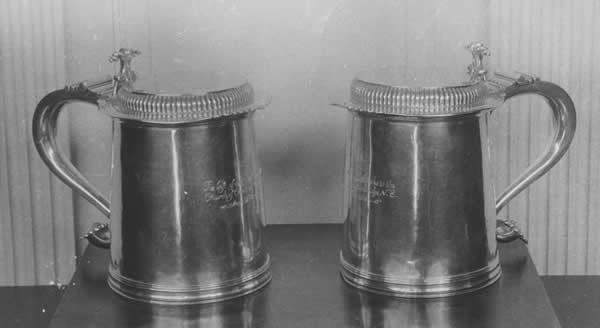Legacy Silver
A Powerful Symbol of Early American Democracy and Enslavement
By Gloria Korsman
The Dummer bowl, a silver basin sometimes used in worship, is one of several pieces of American silver belonging to the First Parish in Cambridge and on loan to the Museum of Fine Arts, Boston. Jeremiah Dummer (1645–1718) made the bowl. Reverend William Brattle, minister from 1696 to 1717, left the bowl to us in his will. Not only was Brattle our minister, he was a tutor, fellow, and treasurer of Harvard. He also enslaved at least two people of African descent, Scipio and Cicely, whose names appear in our earliest records. Cicely’s tombstone stands in the burial ground next to our building.
William Brattle’s students gave him the bowl in 1695. The Brattle coat of arms is engraved on the rim. The bowl bears Dummer’s mark, a heart-shaped device within which are his initials, with a small pellet between the initial, and a fleur-de-lis. It was made for domestic use. Rosewater dishes or basins were used at feasts before the advent of forks and knives; between courses a basin would be passed, with a napkin, to guests. Cicely would have handled the bowl. Scipio chose to be baptized on June 10, 1705, likely with water from the Dummer bowl.
Early New England churches used bowls instead of baptismal fonts because a decree came from England to remove all fonts. They used basins in hope that the practice would help to strengthen Protestant teaching on baptism. Of the two rosewater bowls that survived as baptismal basins in New England churches, the Dummer Bowl is the earlier.
Brattle died in 1717. He left the Dummer Bowl to First Parish in Cambridge in his will: “I hereby present to the Church of Christ in Cambridge for a baptismal basin , my great silver basin, an inscription which I leave the prudence of the Revd. President (John Leverett) and the Rd. Mr. Simon Bradstreet.” The inscription that Leverett and Bradstreet selected is “A Baptismal Basin consecrated, bequeathed, and presented to the church of Christ in Cambridge, his dearly beloved flock, by the Revd Mr Wm Brattle Pastr of the Sd Church; who was translated from his charge to his Crown, Febr 15: 1716/1717.”

Tankards
Also on loan to the museum are four tankards. Tankards served as communion silver in colonial New England. The puritans chose everyday drinking vessels to distance themselves from the Roman Catholic tradition of chalices. They preferred vessels associated with convivial gatherings so their ritual would closely resemble the last supper Jesus shared with his disciples. Tankards downplayed social distinctions between clergy and laity, and between members of differing social status. The tankards as symbols of our religious movement’s longstanding commitment to democratic process.
Two of the tankards are a matching pair, with the inscription “The Gift of Mr. William Wilcocks to the | Church of Christ in Cambridge N.E. | Anno Dom 1654”. These tankards were made by John Coney of Boston (1655-1722) and have a cast cherub’s face on the handle. Our church records from 1704 describe the congregation voting to sell land bequeathed by William Wilcocks’ widow that “vessels should be made of ye money for ye Com[m]un[ion] Table”.
Additional tankards were purchased by the congregation before Massachusetts abolished slavery. A third tankard, also made by John Coney, is similar to the Wilcocks’ gift except for the inscription and a slightly different cherub on the handle. The fourth tankard is made by John Burt of Boston (1691-1745) and lacks a cherub. Our records show that enslavers were members and donors to our congregation, enabling us to commission these silver pieces. Why silver, rather than another metal, glass, or pottery? Silver was a great way to preserve wealth. It was durable, could be remade into new objects, and was a valuable currency in all of the British colonies.

